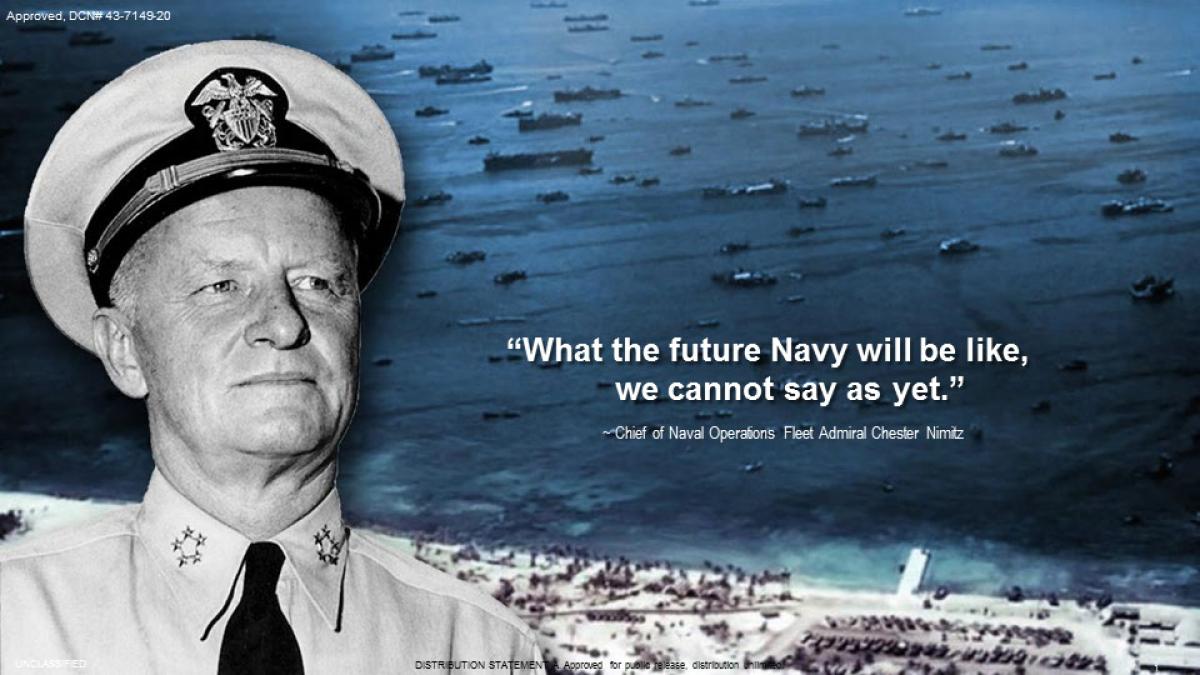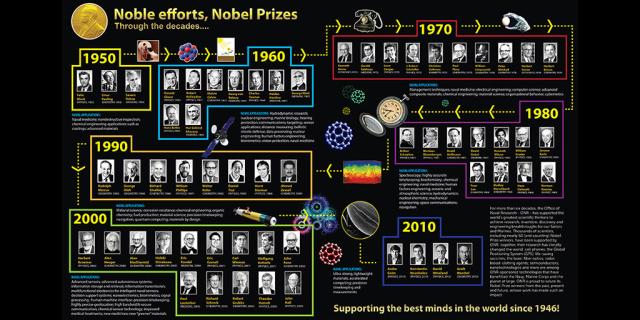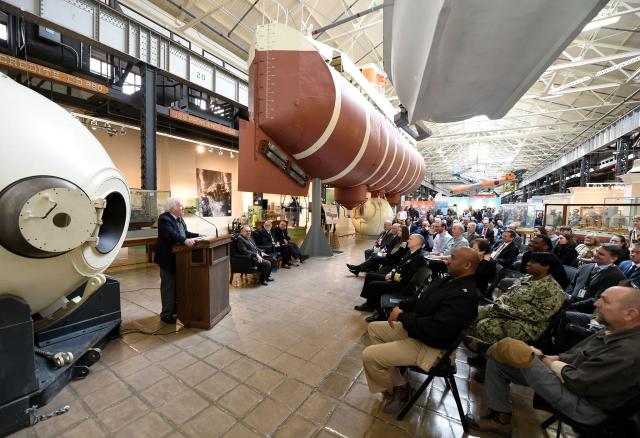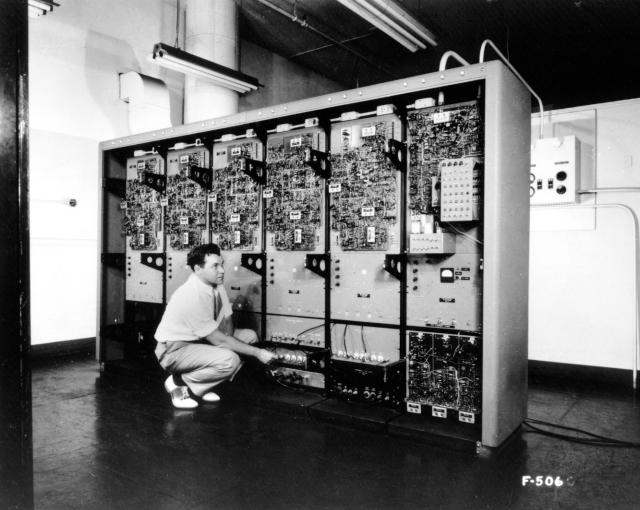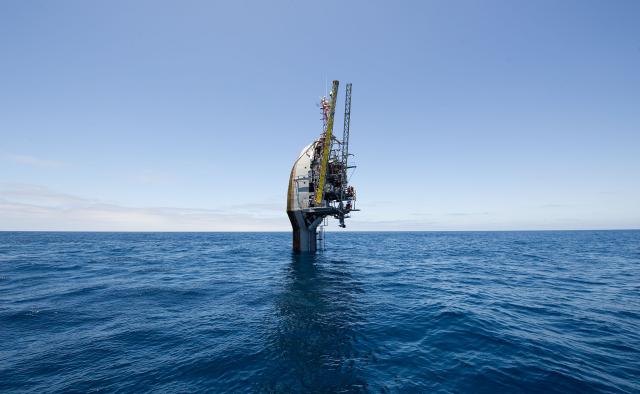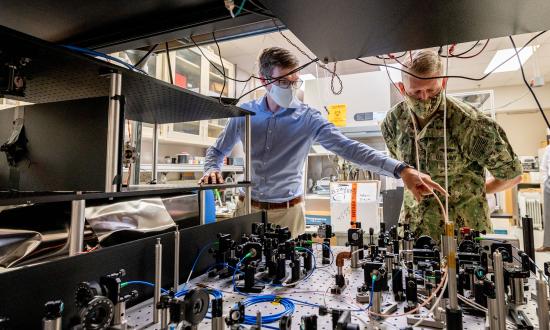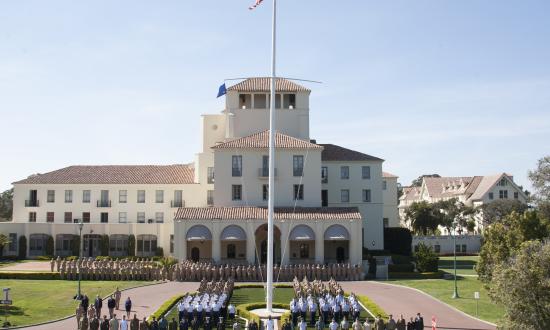As the long conflicts of World War II at last came to an end in 1945, Fleet Admiral Chester Nimitz—one of the greatest naval strategists this nation has ever known—commanded the largest naval armada the world had ever seen. With the United States now the unquestioned leader of the free world (actually coming out of the war with far greater strength than going in), it would have been reasonable for Nimitz, and the rest of the world, to believe the U.S. was holding all the right cards to ensure continued dominance.
Yet Admiral Nimitz knew resting on laurels would not win tomorrow’s battles. The United States had seen dark days during the war—times when the enemy’s technological capabilities had surprised the Allies and led to significant losses in battle. Those surprises started with the attack on Pearl Harbor, when not only the attack itself was a surprise, but the accuracy and power of Japanese torpedoes caught the U.S. Navy off guard. (It would take us a year to catch up on that front alone, an amount of time we will likely never have again in modern conflict.)
Tech surprise came into play also in the Atlantic, where early on German U-boats operated with near impunity until allied anti-submarine capabilities came of age. Even toward the end of the war, the adversary in Europe was working furiously to develop new capabilities for revolutionary V-2 rockets—the world’s first long-range, guided ballistic missiles.
Thankfully, the U.S. had made dramatic technology advances through new partnerships with industry, academia, and allies which proved crucial to victory. Radar played a critical role in success in the battle for the Atlantic and beyond. The Manhattan Project assembled some of the world’s greatest minds and developed the atomic bomb. U.S. industry and government paired up as never before to create multiple new platforms to dominate land, air, and sea, and manufactured them at a scale never seen before. Crucial new materials, such as synthetic rubber, while lacking the star-power of new carriers or bombers, nonetheless played key roles—as did new medical technologies, advances in computers, and even duct tape.
Admiral Nimitz and other key leaders knew that the recent past underscored the importance of imagining the future. And that would extend to the Navy itself. “There will always be a Navy,” he said, “Not necessarily a Navy of battleships, or submarines, or carriers, but a Navy in the sense of what the word Navy truly means…what the future Navy will be like, we cannot say as yet.”
Against this backdrop, in 1946, Congress created the Office of Naval Research (ONR). President Harry Truman signed the bill into law in August 1946—a little over 75 years ago. The bill’s instruction for the new organization: “to plan, foster and encourage scientific research in recognition of its paramount importance as related to the maintenance of future naval power, and the preservation of national security.”
Since its founding, ONR has produced incredible results. ONR sponsored-research has played a key role in the development of GPS, radar, computers, new uses for gallium nitride, new autonomous surface, sub-surface, and airborne platforms, virtual training, tropical cyclone prediction, directed-energy weapons, stealth capabilities, and so much more. The raw knowledge coming out of ONR over the years has been astounding: More than 70 Nobel Prize winners have been sponsored by ONR; in many cases, they have thanked ONR directly for pivotal guidance and partnership.
Naval Research has supported the efforts of dozens of Nobel laureates through the past eight
decades. (ONR)
Impressive as its history is, and as exciting as today’s technologies are, the people of ONR cannot be satisfied with what we have already accomplished. We must continue to forge ahead with an ongoing call to intellectual arms. Today, the Department of the Navy and the nation require us to reimagine naval power, and recognize that, across the Navy and Marine Corps, we must change to maintain naval dominance. Monumental efforts are needed, in the spirit of people like Admiral Hyman Rickover, whose singular focus brought about the nuclear-powered Navy, despite entrenched bureaucracy seemingly designed to slow down dramatic change. I recently introduced the concept of a new “hedge strategy” for the Navy, where newly developed, autonomous platforms and sensors on thousands of unmanned vehicles—the small, the agile, and the many—will complement the Navy’s powerful carriers, aircraft, and submarines. Noted entrepreneur Steve Blank wrote about this strategy in Proceedings earlier this year.
Our nation and the Navy are the better for ONR’s first 75 years of research and development. We must act just as boldly today because what happens in the next 10 years in science and technology may well determine the next 100 years of history. We are at a pivotal moment—and technologies being developed now are going to be akin to James Watt’s steam engine and the subsequent Industrial Revolution that changed the world. Artificial intelligence; autonomous and unmanned capabilities; quantum computing; directed energy; materials science; and biotechnology are today’s equivalents. And, too often-overlooked, the workforce development and STEM educational efforts that drive those advances are what will ensure the U.S. Navy and Marine Corps maintain their edge and ensure a safe and secure nation and global commons.
1946-2021
Eight months before Winston Churchill declared at Westminster College in Missouri that an “iron curtain has descended across” Europe, U.S. naval officers ensured that the postwar Navy would have the services of the first military organization dedicated to advancing civilian science and technology for future readiness. Originally founded on a temporary basis in July 1945 as the Office of Research and Invention on the authority of the Secretary of the Navy and the War Powers Act, the new organization was the product of what had been learned from the national mobilization of science for the war.
Soon renamed the Office of Naval Research, the command had a revolutionary mission: to support science in the interest of national security, in peacetime as well as wartime. As had Nimitz, Vice Admiral Harold Bowen, the first Chief of Naval Research, championed the argument that readiness was no longer something that could happen after a conflict had begun. Enduring technological advantage was a national security imperative.
As the Naval STEM Executive, I believe that maxim has never been truer. To maintain that technical advantage, we need to view our naval STEM workforce as a matter of national security. Our edge will continue to come from great ideas; the great ideas will come from a unique, diverse workforce; but that STEM-inspired workforce will not just magically appear—it must be supported and nurtured. Holistically, if we are to succeed in a rapidly-changing technological landscape, our brightest young minds in general—and formal educational organizations, including university STEM programs and historically black colleges and universities and minority-serving institutions in particular—must be viewed as national assets. Within the Naval Research Enterprise—which includes ONR, ONR Global, the Naval Research Laboratory and PMR-51—we are prioritizing support to these programs as foundations of the future.
Across the globe, determined adversaries are rapidly developing advanced weapon systems, shrinking (or in some cases overcoming) the capability advantage U.S. forces have long enjoyed. To maintain or regain our edge, ONR is engaged in scientific and engineering efforts from the ocean floor to space.
Let’s start with the oceans. It is here that ONR made some of its most well-known impacts. Indeed, the field of oceanography itself likely would not exist as it does today without ONR’s early and persistent investments after World War II. Early efforts in wave prediction and acoustics, many headed by the late “Einstein of the Sea,” Walter Munk, contributed to our understanding of the oceans and expertise in undersea warfare. Marie Tharp and Bruce Heezen developed the first comprehensive three-dimensional map of the seafloor, which was essential to the later formulation of the theory of plate tectonics. Sponsored research in deep-submergence technology resulted in the record-breaking dive to the bottom of the world’s ocean in 1960, when Navy Lieutenant Don Walsh and explorer Jacques Piccard went to the bottom of Challenger Deep in the Mariana’s Trench on board the bathyscaphe Trieste.
and 1960s. Here Don Walsh speaks at the 60th anniversary of the Challenger Deep dive in
January 2020. (ONR)
It didn’t stop there. ONR’s support for basic research in the 1970s resulted in the discovery of undersea hydrothermal vents, and an entirely new form of life sustained by chemosynthesis—work led by Robert Ballard. And the latest generation of networked sensor platforms, such as floats, gliders, and remote vehicles, originally developed with ONR support to study ocean dynamics and climate change, provides the means for real-time maritime domain awareness today.
In addition to discoveries in the oceans, ONR continues to lead in developing the vehicles, sensors, platforms, and ships that make all these discoveries possible. These efforts include everything from building submersibles such as Alvin, launched in 1964, and unique vessels such as the Floating Instrument Platform (FLIP), to providing many of the nation’s largest ocean-going research ships such as the venerable R/V Melville (AGOR-14) and R/V Knorr (AGOR-15), each of which provided more than 40 years of service, and the current R/V Sally Ride (AGOR-28) and R/V Neil Armstrong (AGOR-27).
ONR’s impact goes beyond marine sciences. One of its earliest projects in the 1940s, Project Whirlwind, resulted in the first digital computer capable of real-time computing. Originally intended to control a next-generation flight simulator, Whirlwind would eventually be incorporated as the heart of the first strategic air defense early-warning system. Today, nearly every device that contains a real-time computing device—from the computer in your car to the servers that monitor daily shipping traffic—owes something to ONR’s early work in digital computing.
ONR-sponsored research aided in the development and enhancement of the atomic clock, an essential and necessary component to the satellite navigation systems upon which so much of modern life depends. Early investments in directed energy supported the research of Charles Townes, who invented the microwave amplification by simulated emission of radiation (maser) in the 1950s and contributed to later development of the light amplification by simulated emission of radiation (laser). Those investments came full circle in 2014, as ONR deployed the first laser weapon system on a warship, the USS Ponce (AFSB(I)-15)—and today has put a far more powerful laser aboard USS Portland (LPD 27). ONR-sponsored research in railguns over the past decade resulted in a series of record-breaking kinetic milestones with this next-generation technology. And, ONR has long been at the forefront of new materials for nearly every environment, from explosive-resistant coatings for vehicles and ships, to highly conductive materials such as gallium nitride—found in nearly anything with full-color LED lighting and, more significantly, in high-power radars and electronics.
Warfighter protection efforts have been front and center as well, with significant military and societal significance. Medical research sponsored by ONR has included everything from the SeaLab underwater habitats that helped us understand human interactions underwater, to more recent automated trauma monitoring systems, virtual reality PTSD treatments, and QuikClot, a wound dressing that accelerates blood clotting. Indeed over the years, ONR has supported an array of technologies that have directly benefited Marines, from wearable tactical energy systems, mobile power and logistics systems, to next-generation tactical ground vehicles.
Our work in unmanned systems has led to enormous success and even greater promise ahead—but it is worth noting it took decades to get to the point of such groundbreaking autonomy exercises as the Integrated Battle Problem 21 (IBP21), where over 30 autonomous platforms were successfully tested in blue water operations. Beginning with some of the earliest investments in artificial intelligence that resulted in the first autonomous robot, Shakey, at Stanford University in the 1960s, ONR has been a leader in building and improving autonomous vehicles, automated decision-making, and human-robotic teaming and interactions. This year, our new SCOUT initiative—a novel partnership with the Joint Interagency Task Force-South—will provide impressive new autonomous capabilities to support narcotics interdiction efforts.
ONR’s importance to American science and technology extends beyond research and new capabilities—indeed, the organizational infrastructure that ONR uses to support research and innovation has been replicated across the Department of Defense and beyond. The first deputy chief of ONR, Alan T. Waterman, had served as the director of field operations for the Office of Scientific Research and Development during World War II, and would become the first director of the National Science Foundation when it was founded in 1950. Our peer organizations—the Army Research Office, the Air Force Office of Scientific Research, and the Defense Advanced Research Projects Agency—were founded during the Cold War using the same S&T management principles pioneered by ONR.
Over the decades, a wide range of warfare centers, laboratories, and university-affiliated research centers, have been established and grown into a diverse S&T network, dedicated to advancing innovation. Of all ONR’s many legacies, collaboration between institutions and organizations—military, industrial, and academic—is perhaps the most profound and longest-lasting. Fostering an environment of partnership, from the Naval Research Laboratory and ONR Global, to our sister organizations throughout DoD and beyond, has proven time and again to be essential to advancing modern science and technology.
Moving Forward
As impressive as the organization’s history is, we will not rest on our laurels. The challenges facing our Nation today are grave. To ensure continued deterrent-level dominance over increasingly sophisticated state and non-state actors, we must in this decade overcome our own well-intentioned bureaucratic hurdles, which may have once been useful but are no longer. As happens periodically, there come tipping points where what has worked well in the past—how we operate both internally as well as externally with our partners—is no longer effective.
In that spirit, ONR has expanded its paradigms and vision. In the early decades, ONR was optimized as a basic research organization focused on discovery in universities and basic research institutions. In the 1980s and early 1990s, though, as the Cold War was ending, ONR took on more applied research and advanced technology development. In the past 30 years, we have added new ways to approach innovation. Examples include: TechSolutions, which takes ideas from Sailors and Marines to swiftly produce working prototypes; Future Naval Capabilities, which accelerate cutting-edge technologies into the fleet and force; and Innovative Naval Prototypes, which take seemingly “over the top” ideas, technologically, and explores finding the next game-changing capability.
Institution of Oceanography. (U.S. Navy photo by John F. Williams)
Innovation is not only about platforms or technologies. We must also rethink how we do business. For some programs, it will take decades to “get there.” But for others, our research is so close to maturity that we simply cannot accept slow contracting processes, constrained funding lines, and inability to get on ship modernization schedules. Our sailors and Marines need capabilities now. We can better utilize tools that already exist to get things done—including newer forms of funding, such as Partnership Intermediary Agreements (PIAs), Other Transactional Authorities (OTAs), hackathons and prize challenges, new internships, and creative academic programs such as multidisciplinary university research initiatives (MURIs), and more, all of which can accelerate innovation deliveries.
One of the key ways we’re doing this is through our Naval X program, with its associated Tech Bridges. At its essence, Naval X is a new way of inspiring collaboration and fostering new paths for new ideas. The Tech Bridges, envisioned as a new kind of collaborative workspace and uninhibited idea factory, have taken off around the country and now, around the world, with new ones in London, U.K., and Yokosuka, Japan.
Too often, projects fail to move from advanced technology development to component development and prototyping. Bureaucracy and complacency are powerful and omnipresent, poised to grab onto promising projects and stymy them. We must overcome these obstacles—go around them, over them, and do whatever it takes to defeat them. I do not have all the answers on how to do that, but we are making progress and eagerly looking to new ways of doing business. If you have a great idea, the Naval Research Enterprise wants to talk with you.
As I meet with thought leaders around the country, including author and entrepreneur Safi Bachall, MIT lecturer and author Steven Spear, process guru Steve Blank at Stanford, and other brilliant folks from government, industry and academia, I am hearing excitement about what ONR is trying to do and agreement that the time to act is now.
As it has for 75 years, ONR is pursuing the future with a sense of determination, and optimism. Yes, our adversaries are moving quickly, fielding new technologies and weapons faster than they have ever been. But ONR is answering the challenge with a sense of optimism. Working with civilian universities, industry large and small, other government labs, and our allies, we will continue to provide the technological edge that allows the U.S. Navy and Marine Corps to adapt, survive, and win.



